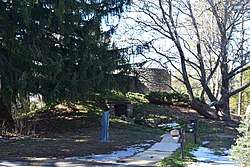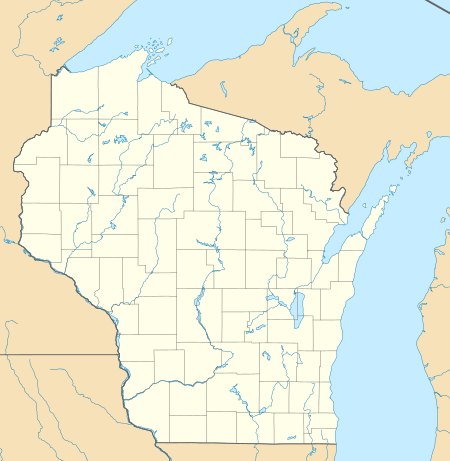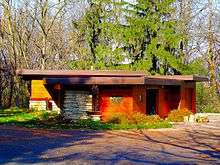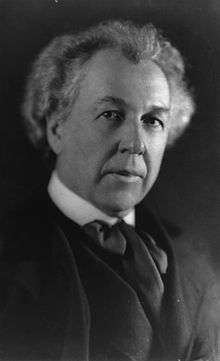Herbert and Katherine Jacobs Second House
Herbert and Katherine Jacobs Second House is a historic house located at 3995 Shawn Trail in Madison, Wisconsin, United States. Built in 1946-48, the house was the second of two designed by Frank Lloyd Wright for journalist Herbert Jacobs and his wife Katherine. The house's design is unique among Wright's works; he called the style the "Solar Hemicycle" due to its semicircular layout and use of natural materials to conserve solar energy.[4] The house was added to the National Register of Historic Places in 1974 and declared a National Historic Landmark in 2003.[3][2]
Herbert and Katherine Jacobs Second House | |
 Northeast entrance to the house | |
  | |
| Location | 3995 Shawn Trail Madison, Wisconsin United States |
|---|---|
| Coordinates | 43°4′26″N 89°32′5″W |
| Built | 1946-1948[1](pp17–20) |
| Architect | Frank Lloyd Wright |
| Architectural style | Modern Movement, Other |
| NRHP reference No. | 74000074 |
| Significant dates | |
| Added to NRHP | December 31, 1974[2] |
| Designated NHL | July 31, 2003[3] |
History and architecture
Wright was a close personal friend of the Jacobs couple. He designed his first house for them in 1936 and that house was Wright's first experiment with a Usonian design, his vision for affordable housing in the United States. The Jacobses moved to a more rural part of the Madison area in 1942 to become part-time farmers; as they had to give up their original home, they asked Wright to design a new one for them. After initially proposing an existing plan that another client had not completed, Wright proposed another experimental plan for the new house in 1944. Due to delays on Wright's part, construction did not begin until 1946, and most of the work did not take place until 1948. By this point, Wright had become offended by a comment Herbert had made in We Chose the Country, one of his works, and he left the couple to build the house themselves without his guidance.[1]

Wright gave the house a unique design which he called a "Solar Hemicycle". The house's plan is a segment of a circle, a design which Wright borrowed from an unbuilt plan he made for Lloyd Burlingham in 1942. Circular rooms and elements, such as the house's bathroom, fireplace, and pools, came from a 1938 design which was later built on the grounds of Taliesin West. Wright had the house built from stone, concrete, and wood, materials which would allow the house to retain solar energy; the design represents an early attempt at energy-efficient architecture. The house's north berm was originally proposed as an easily built stone wall for a community in Detroit; in the Jacobs house, it serves as a windbreak which prevents strong winds from damaging the glass windows. Due to their weight, the house's stone walls were not built on the concrete floor, as was common in other Wright houses; rather, deep foundations filled with crushed stone supported the walls. Unlike many of Wright's works, the design was never reused or modified for later clients; while two clients purchased plans which were effectively reflections of the house, they were never constructed.[1]
See also
References
- Sprague, Paul (July 21, 2001). "National Historic Landmark Nomination: Jacobs, Herbert and Katherine, Second House" (PDF). National Park Service. Retrieved April 19, 2015.
- "National Register Information System". National Register of Historic Places. National Park Service. January 23, 2007.
- "Herbert and Katherine Jacobs Second House". National Historic Landmark summary listing. National Park Service. Archived from the original on 2009-04-03. Retrieved 2013-09-12.
- Denzer, Anthony (2013). The Solar House: Pioneering Sustainable Design. Rizzoli.
- Storrer, William Allin. The Frank Lloyd Wright Companion. University Of Chicago Press, 2006, ISBN 0-226-77621-2 (S.283)
External links
| Wikimedia Commons has media related to Herbert and Katherine Jacobs Second House. |
